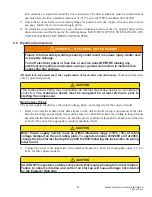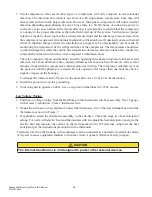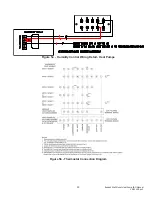
43
Eubank Wall Mount Heat Pump I&O Manual
05/2023 Rev.2
5.2 Failure Symptoms Guide
PROBLEM/SYMPTOM
LIKELY CAUSE(S)
CORRECTION
A. Unit does not run.
NOTE: An internal anti-short-cycle
timer will prevent the unit
from starting for .2 to 8
minutes following start-up.
1. Power supply problem.
2. Tripped internal disconnect.
3. Shut off by external thermostat or
thermostat is defective.
4. Unit off on high pressure or loss of
charge.
5. Internal component or connection
failure.
1. Check power supply for adequate phase and
voltage. Check wiring to unit and external
breakers or fuses.
2. Check circuit protection devices for
continuity.
3. Check operation of wall-mounted thermostat.
4. Reset lockout. See section 1.4.
5. Check for loose wiring. Check components
for failure.
B. Unit runs for long periods or
continuously; cooling is insufficient.
1. Unit undersized for job.
2. Low refrigerant.
3. Component failure.
4. Dirty filter or reduced airflow.
1. Add additional units for greater capacity.
2. Check for proper charge and possible refrig-
erant leak.
3. Check internal components, especially com-
pressor for proper operation.
4. Check air filter(s). Check blower operation.
Remove airflow restriction.
C. Unit cycles on high pressure or
loss of charge.
1. Loss or restriction of airflow.
2. Restriction in refrigerant circuit.
3. Refrigerant overcharge (following
field service)
4. Defective high pressure control or
loss of charge switch.
1. Check blower assembly for proper opera-
tion. Look for airflow restrictions, e.g., the air
filter. Check blower motor and condenser fan.
Indoor blower fan speed control set too low.
2. Check for blockage or restriction, especially
filter drier and capillary tube assembly.
3. Evacuate and recharge to factory
specifications.
4. Check limit cutout pressures. Control is set to actu-
ate at approximately 40 PSIG (loss of charge)
and 610 PSIG (high pressure).
D. Unit blows fuses or trips circuit
breaker.
1. Inadequate circuit ampacity.
2. Short, loose, or improper connection
in field wiring.
3. Internal short circuit. Loose or
improper connection(s) in unit.
4. Excessively high or low supply volt-
age or phase loss (3ø only).
1. Note electrical requirements in Chapter 2 and
correct as necessary.
2. Check field wiring for errors.
3. Check wiring in unit. See wiring and sche-
matic diagrams. Test components (especially
the compressor) for shorts.
4. Note voltage range limitations specific to the
compressor troubleshooting section.
















































